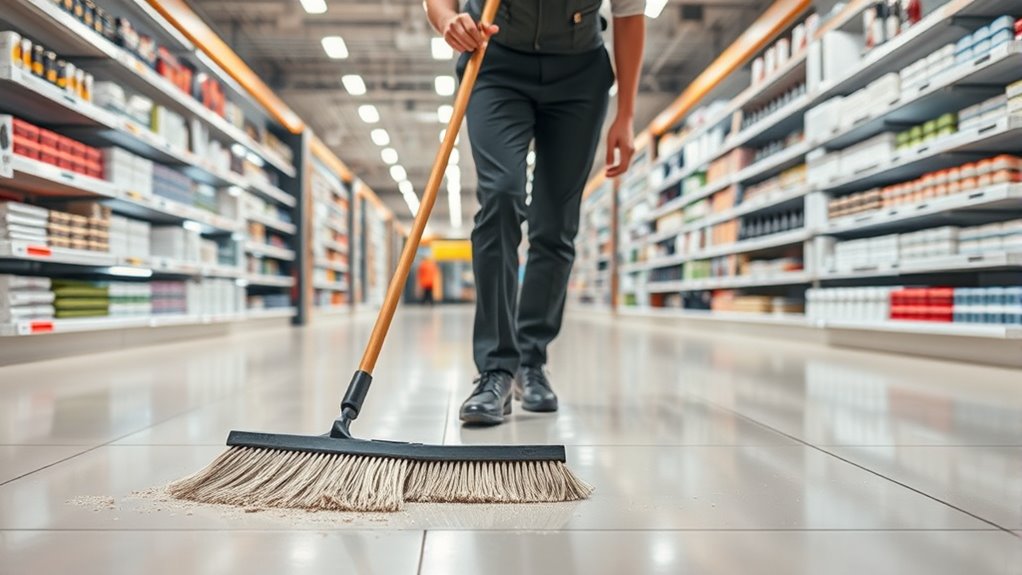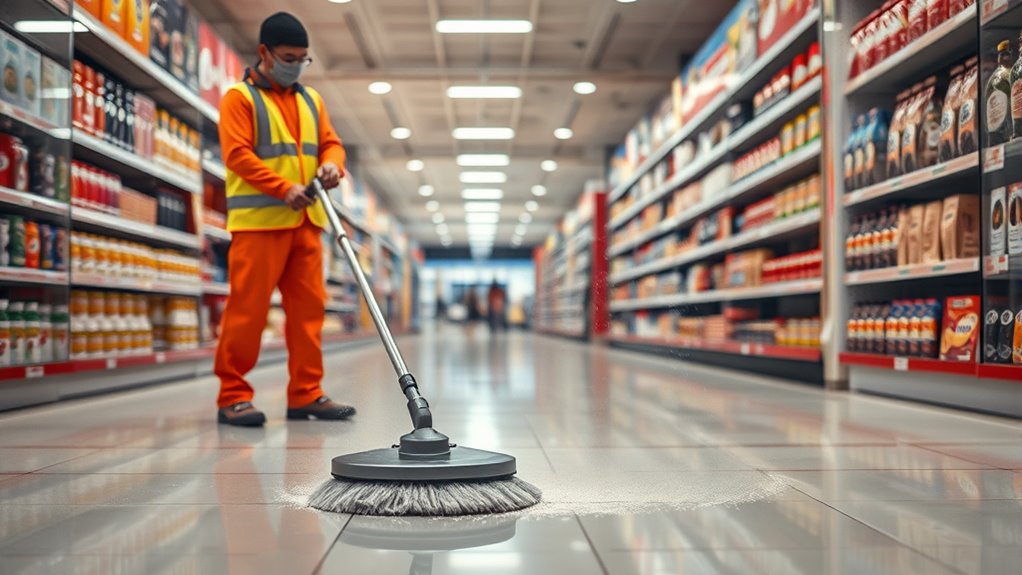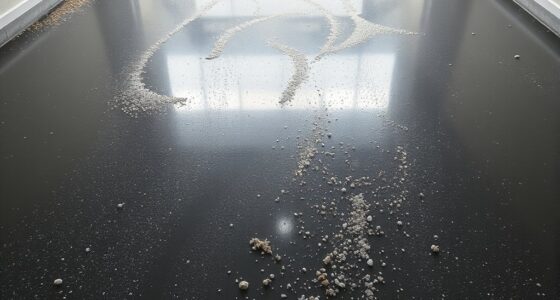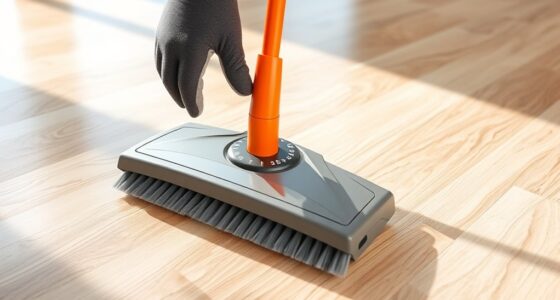To beat fine dust in shop aisles, adopt a two-pass sweeping plan. First, loosen and gather larger debris and loose dust with a suitable broom or sweeper, ensuring proper equipment and filters are used. Then, make a second pass to capture the fine dust missed initially. Regular equipment maintenance, staff training, and choosing the right tools are key. Keep going to discover how perfecting these steps improves cleanliness and air quality effectively.
Key Takeaways
- Implement a two-pass sweeping method: first loosen debris, then capture fine dust for thorough cleanliness.
- Use equipment with high-efficiency filters or vacuum attachments to improve fine dust removal.
- Regularly inspect and replace worn brushes and clean filters to maintain optimal sweeping performance.
- Train staff on proper sweeping techniques to ensure dust is directed into collection bins effectively.
- Schedule routine maintenance and cleaning to prevent dust buildup and prolong equipment lifespan.

Have you ever wondered how to keep your aisles spotless and debris-free efficiently? The key lies in adopting a strategic sweeping plan that tackles fine dust and debris in two precise passes. This approach not only ensures cleaner aisles but also markedly reduces dust buildup, which can affect air quality and safety in your workspace. To achieve this, you need to focus on effective dust control and proper equipment maintenance, both of which play essential roles in maintaining the longevity and performance of your sweeping tools. Regularly inspecting and maintaining your equipment helps prevent issues like worn brushes and clogged filters, which can diminish dust collection efficiency. Start by understanding that the first pass is designed to loosen and gather the larger debris and loose dust particles. Use a broom or a sweeper equipped with the right brushes and filters to maximize dust control. Regularly inspect and maintain your equipment to guarantee peak performance. Dirty or worn brushes won’t sweep effectively, and clogged filters can reduce airflow, making dust control less efficient. Keeping your equipment in top shape means changing brushes when they wear out and cleaning filters regularly, which helps trap fine dust before it becomes airborne. Once you’ve completed the initial pass, switch to the second pass to focus on capturing the fine dust that the first sweep may have missed. Use a sweeper with high-efficiency filters or a vacuum attachment if possible. This second step is essential because it ensures that the smallest particles, which can linger on surfaces or become airborne, are thoroughly removed. Proper dust control during this stage prevents dust from settling again and reduces the risk of respiratory issues or machinery contamination. To maximize the effectiveness of your two-pass sweeping plan, consider scheduling regular equipment maintenance routines. This includes checking belts, lubricating moving parts, and replacing worn brushes or filters. Well-maintained equipment doesn’t just sweep better; it also lasts longer, saving you money on repairs and replacements in the long run. Additionally, training your staff on correct sweeping techniques and the importance of dust control can make a notable difference. Proper technique ensures dust is directed into collection bins rather than spread around, and staff awareness promotes consistent maintenance practices. Incorporating proper equipment maintenance into your routine is essential to sustain the efficiency of your cleaning process and prevent dust buildup over time.
Frequently Asked Questions
What Types of Brooms Are Best for Fine Dust?
For fine dust, you’ll want brooms with soft bristles made from natural or synthetic materials like flagged polypropylene or horsehair. These broom materials help with dust containment by gently sweeping without scattering particles. Look for a broom with fine, dense bristles to effectively trap dust on the surface. Using the right broom guarantees minimal dust escape, keeping your shop aisle cleaner and safer.
How Often Should Shop Aisles Be Swept?
You should sweep your shop aisles daily to maintain dust control and keep the environment safe. Regular sweeping prevents dust buildup, reducing health hazards and equipment wear. Make sure to inspect and maintain your sweeping equipment frequently to guarantee peak performance. Proper equipment maintenance helps the broom effectively picks up fine dust, making your cleaning routine more efficient and keeping your aisles cleaner and safer for everyone.
Can Sweeping Methods Reduce Allergen Levels?
Sweeping methods are like a shield against allergens, actively reducing their presence. By implementing effective dust mitigation strategies and improving air filtration, you can markedly lower allergen levels in your shop. Regular sweeping, especially with a two-pass approach, helps trap fine dust before it becomes airborne, making the environment healthier for everyone. So, yes, proper sweeping can make a real difference in allergen control.
What Safety Precautions Are Necessary During Sweeping?
You should wear protective gear like masks and gloves to prevent inhaling dust particles during sweeping. Make certain your ventilation systems are fully operational to disperse airborne dust and reduce health risks. Keep the area well-ventilated, and consider using dust extraction tools for added safety. Regularly check and maintain equipment to minimize exposure, and follow safety protocols to protect yourself from allergens and fine dust during the sweeping process.
How Do Weather Conditions Affect Dust Accumulation?
Weather impacts dust formation and accumulation, affecting how much dust you need to manage. Humid conditions cause dust to settle more quickly, reducing airborne particles but increasing surface residue. Conversely, dry, windy weather stirs up dust, making it harder to control and requiring more frequent sweeping. Recognize that weather conditions directly influence dust behavior, so adapting your cleaning strategies accordingly helps maintain a cleaner, safer environment in your shop aisles.
Conclusion
By following the two-pass sweeping plan, you’ll keep shop aisles cleaner and safer for everyone. Remember, “A stitch in time saves nine,” so taking that extra sweep helps prevent dust buildup and future messes. Stay consistent with your cleaning routine, and you’ll notice a noticeable difference in your shop’s cleanliness. Keep dust at bay with this simple method, and your aisles will remain tidy and inviting for customers and staff alike.









